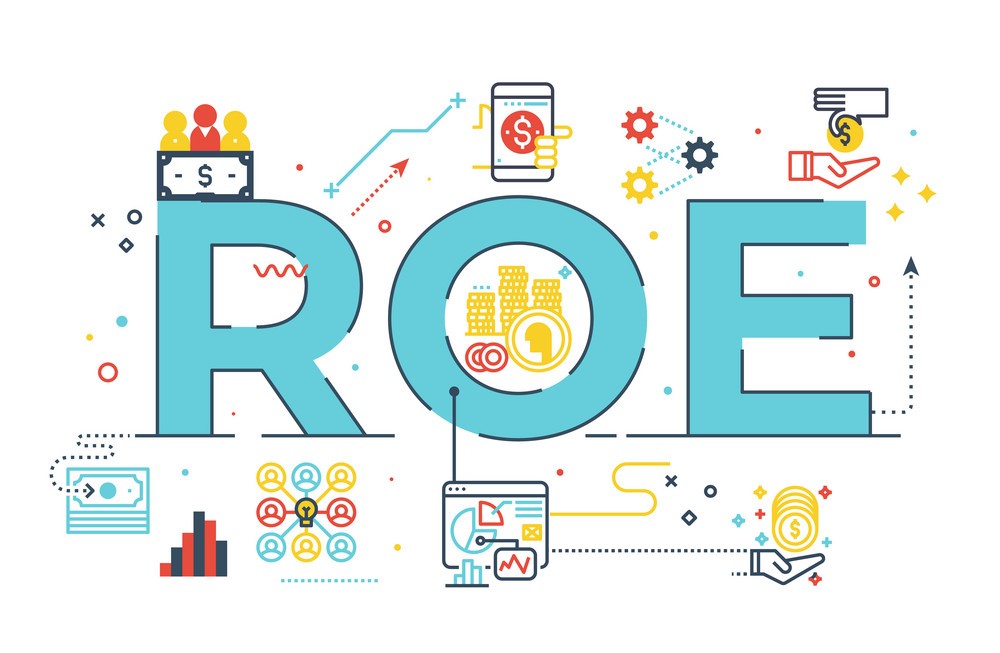What factors affect a company's ROE, and how can they enhance it?
Return on Equity (ROE) is a financial metric that measures a company’s profitability about its shareholders’ equity. It provides insight into how efficiently a company is utilizing its equity to generate profits. ROE is calculated by dividing net income by shareholders’ equity, expressed as a percentage.
ROE is a crucial metric for investors and analysts as it indicates how effectively a company is generating profits from the capital invested by its shareholders. A high ROE suggests that the company is efficiently using shareholders’ funds to generate earnings, while a low ROE may indicate inefficiency or excessive leveraging.
A higher ROE is generally desirable, but it’s essential to consider industry norms and compare ROE with competitors to assess performance accurately. Additionally, ROE can be influenced by factors such as debt levels, profit margins, asset turnover, and tax rates.
Accounts payable process flow involves the steps and procedures a company follows to manage its accounts payable, which are amounts owed to suppliers and vendors for goods and services purchased on credit. Integrating this topic into the discussion of ROE emphasizes the importance of managing liabilities effectively.
In the accounts payable process, companies receive invoices from suppliers, verify the accuracy of the charges, and then record the amounts owed in their accounting records. Payment terms are negotiated with suppliers to optimize cash flow and minimize costs. Efficient management of accounts payable can positively impact ROE by reducing expenses and improving working capital management.
By ensuring timely payment of invoices and taking advantage of early payment discounts, companies can enhance their liquidity position and potentially reduce financing costs, thus positively impacting profitability and ROE.
In conclusion, understanding Return on Equity is essential for assessing a company’s profitability and efficiency in utilizing shareholder funds. Integrating accounts payable processes into discussions of ROE underscores the importance of managing liabilities effectively to enhance financial performance and shareholder value.
How its work?
Return on Equity (ROE) is a crucial financial metric used by investors and analysts to evaluate the profitability and efficiency of a company in generating profits from its shareholders’ equity. Essentially, ROE measures how much profit a company generates with the money shareholders have invested.
ROE provides insight into how efficiently a company is using its equity capital to generate profits. A higher ROE indicates that the company is generating more profit with less investment from shareholders, which is generally seen as a positive sign of efficiency and profitability. Conversely, a lower ROE may suggest that the company is not effectively utilizing its equity capital.
Now, let’s integrate the accounts payable process flow into this discussion.
Accounts payable are a crucial component of a company’s financial operations, representing the money owed by a company to its suppliers for goods and services purchased on credit. The accounts payable process involves various steps, including receiving and verifying invoices, recording the payable amounts, and ultimately making payments to suppliers within the agreed-upon terms.
Efficient management of accounts payable can positively impact a company’s ROE in several ways. For instance, by effectively managing payment terms with suppliers, a company can optimize its cash flow and working capital, thus potentially improving its return on equity. Additionally, timely payment of accounts payable can help maintain good relationships with suppliers, which may lead to favorable terms and discounts, further enhancing profitability.
In summary, while ROE primarily focuses on assessing a company’s profitability and efficiency in generating returns from shareholders’ equity, integrating considerations of the accounts payable process flow underscores the importance of effective financial management practices in maximizing ROE and overall shareholder value.
How to calculate Return on Equity?
Return on Equity (ROE) is a financial metric that measures a company’s profitability relative to its shareholders’ equity. It indicates how effectively a company is using its shareholders’ equity to generate profit. ROE is an important measure for investors, as it helps assess the efficiency and profitability of a company’s operations.
Here’s how to calculate ROE:
- Net Income: Start by finding the company’s net income. This figure can typically be found on the company’s income statement. Net income is the total revenue minus all expenses, taxes, and interest payments.
- Shareholders’ Equity: Next, determine the company’s shareholders’ equity. This can usually be found on the company’s balance sheet. Shareholders’ equity represents the total value of the company’s assets minus its liabilities. It’s essentially what would be left for shareholders if all the company’s debts were paid off.
- Calculate ROE: Once you have both the net income and shareholders’ equity figures, you can calculate ROE using the following formula:
ROE=NetIncome
Shareholders Equity×100%′
This formula expresses ROE as a percentage. It shows how much profit the company generates with each dollar of shareholders’ equity.
Here are some additional points to consider when interpreting ROE:
- Industry Comparison: ROE is best used for comparing companies within the same industry, as different industries have different norms for ROE due to variations in capital structure and business models.
- Historical Comparison: It’s also useful to compare a company’s current ROE to its historical ROE. This can help identify trends in the company’s profitability and efficiency over time.
- Quality of Earnings: While a high ROE is generally favorable, it’s essential to consider the quality of earnings that contribute to the net income figure. Sustainable, recurring earnings are preferable to one-time gains or earnings from unsustainable practices.
- Leverage: ROE can be influenced by a company’s capital structure and leverage. Companies with higher levels of debt may have higher ROE due to financial leverage, but this also increases the risk.
- ROE Decomposition: ROE can be further broken down into its components, such as profit margin, asset turnover, and financial leverage, to gain deeper insights into the drivers of profitability.
In summary, Return on Equity is a vital financial metric that provides insight into a company’s profitability and efficiency in utilizing shareholders’ equity. By understanding how to calculate and interpret ROE, investors can make more informed decisions when evaluating investment opportunities.
"Mastering Return on Equity (ROE): Formulas and Real-World Examples"
What are some examples of calculating Return on Equity (ROE)?
Sure, here’s a detailed description of the Return on Equity (ROE) calculation along with four examples:
ROE Calculation:
Return on Equity (ROE) is a financial ratio that measures the profitability of a company by expressing its net income as a percentage of shareholders’ equity. It’s calculated using the following formula:
ROE = (Net Income) / (Shareholders’ Equity)x 100
Where:
– Net Income is the profit after taxes and all other expenses.
– Shareholders’ Equity represents the amount of equity invested in the company by its shareholders.
Examples:
Example 1: Company A
– Net Income: $500,000
– Shareholders’ Equity: $2,000,000
ROE = (Net Income) / (Shareholders’ Equity)x 100
ROE = ($500,000) / ($2,000,000)x 100
= 25%
Example 2: Company B
– Net Income: $750,000
– Shareholders’ Equity: $5,000,000
ROE = ( $750,000) / ($5,000,000)x 100
= 15%
Example 3: Company C
– Net Income: $1,200,000
– Shareholders’ Equity: $8,500,000
ROE =( $1,200,000) / ($8,500,000)x 100
= 14.12%
Example 4: Company D
– Net Income: $900,000
– Shareholders’ Equity: $6,500,000
ROE =($900,000) / ($6,500,000)x 100
= 13.85%
These examples illustrate how ROE can vary across different companies, even within the same industry, based on their profitability relative to their shareholders’ equity. A higher ROE generally indicates that a company is using its shareholders’ equity effectively to generate profits. However, it’s essential to consider other factors such as industry norms, company size, and risk profiles when interpreting ROE.

How do you interpret Return on Equity (ROE)?
Interpreting Return on Equity (ROE) is crucial for investors, analysts, and managers as it provides insights into a company’s profitability and efficiency in utilizing shareholders’ equity to generate profits. ROE is a financial metric that calculates the return generated by a company on its shareholders’ equity.
Here’s a detailed description of how to interpret ROE:
- Definition of ROE: ROE is calculated by dividing net income by shareholders’ equity. It’s expressed as a percentage. The formula is: ROE = Net Income / Shareholders’ Equity.
- Understanding Shareholders’ Equity: Shareholders’ equity represents the residual interest in the assets of a company after deducting liabilities. It’s essentially what shareholders would theoretically own if all debts were paid off. It consists of common stock, preferred stock, retained earnings, and additional paid-in capital.
- ROE as a Measure of Profitability: ROE indicates how effectively a company is generating profits from the equity invested by its shareholders. A higher ROE typically indicates better profitability. However, it’s essential to compare ROE with similar companies in the industry, as different industries may have different ROE benchmarks due to variations in capital structure and business models.
- Components of ROE: ROE can be decomposed into three components using the DuPont analysis:
- Profit Margin: Net income divided by revenue, indicating how much profit a company generates from each dollar of sales.
- Asset Turnover: Revenue divided by average total assets, showing how efficiently a company utilizes its assets to generate sales.
- Financial Leverage: Average total assets divided by average shareholders’ equity, reflecting the degree of leverage or financial risk taken on by the company.
- Analyzing Changes in ROE Over Time: Monitoring changes in ROE over multiple periods can provide insights into a company’s financial health and performance trends. Consistent or improving ROE indicates effective management of assets and profitability. Declining ROE may signal operational inefficiencies, increased financial leverage, or declining profitability.
- ROE in Relation to Industry Averages: Comparing a company’s ROE with industry peers can help assess its competitive position and operational efficiency. A higher ROE than industry averages may indicate a competitive advantage or superior management performance. Conversely, a lower ROE may suggest weaknesses or inefficiencies compared to industry peers.
- Considerations and Limitations: While ROE is a valuable metric, it’s essential to consider its limitations. For instance, ROE does not consider the risk associated with achieving the returns, nor does it account for the cost of equity capital. Additionally, ROE can be manipulated through financial engineering, such as share buybacks or debt restructuring.
"From Theory to Practice: Return on Equity (ROE) Formulas with Illustrative Examples"
What are the limitations of using Return on Equity (ROE) as a performance measure?
Return on equity (ROE) is a financial metric used to measure a company’s profitability by evaluating how much profit a company generates with the shareholders’ equity. While ROE is a valuable tool for assessing a company’s performance, it has several limitations that investors and analysts should be aware of:
- Accounting Practices: ROE can be influenced by the accounting methods used by a company. Different accounting practices can lead to variations in reported earnings, which in turn affect the calculation of ROE. This can make it challenging to compare ROE across companies or industries.
- Leverage: ROE does not consider a company’s debt or leverage. A company can increase its ROE by taking on more debt, which amplifies returns on equity capital. However, high leverage also increases financial risk and can lead to volatility in earnings and stock prices.
- Industry Differences: ROE varies significantly across industries due to differences in capital intensity, profit margins, and business models. Comparing ROE between companies in different industries may not provide meaningful insights, as what constitutes a high or low ROE can differ widely.
- Asset Intensity: ROE does not take into account the asset intensity of a business. Some industries require heavy investment in assets such as property, plant, and equipment (PP&E), which can depress ROE compared to asset-light industries.
- Quality of Earnings: ROE may not accurately reflect the quality of a company’s earnings. For example, a company may boost its ROE through aggressive accounting practices, such as recognizing revenue prematurely or deferring expenses. These practices can inflate short-term profitability but may not be sustainable or reflective of the company’s true performance.
- Share Buybacks: ROE can be artificially inflated by share buybacks. By repurchasing shares, a company reduces its equity base, which can lead to a higher ROE even if the underlying profitability remains unchanged.
- Timing Issues: ROE is a backward-looking metric that reflects past performance. It may not capture changes in the business environment or future prospects, making it less useful for forecasting or assessing a company’s current value.
- External Factors: ROE can be influenced by external factors such as changes in interest rates, economic conditions, or regulatory changes. These factors may impact a company’s profitability and financial structure, making it difficult to interpret changes in ROE accurately.

What are the benefits of interpreting Return on Equity (ROE)?
Financial Performance Evaluation: Understanding ROE formulas and examples allows for effective evaluation of a company’s financial performance. ROE provides insight into how efficiently a company is utilizing its equity to generate profits.
Investment Analysis: ROE is a critical metric for investors to assess the profitability and efficiency of a company. Learning about ROE formulas and examples helps investors make informed investment decisions by comparing ROE values across different companies and industries.
Strategic Decision-Making: ROE can influence strategic decision-making within a company. By understanding ROE formulas and examples, company executives can identify areas for improvement in operational efficiency and profitability.
Financial Planning: ROE analysis assists in financial planning and forecasting. Companies can use ROE metrics to set realistic financial goals, allocate resources effectively, and track progress over time.
Competitive Benchmarking: ROE serves as a benchmark for comparing a company’s performance with its competitors. Learning about ROE formulas and examples enables businesses to assess their competitive position within the industry.
Stakeholder Communication: ROE metrics are often communicated to stakeholders, including shareholders, lenders, and analysts. Understanding ROE formulas and examples facilitates clear and concise communication of financial performance indicators.
Performance Monitoring: ROE analysis helps monitor changes in a company’s financial performance over time. By learning about ROE formulas and examples, businesses can identify trends, assess the effectiveness of strategic initiatives, and take corrective actions if necessary.
Risk Management: ROE analysis can uncover potential risks and weaknesses in a company’s financial structure. Learning about ROE formulas and examples assists in identifying areas of concern and implementing risk mitigation strategies.
Educational Resource: Understanding ROE formulas and examples serves as an educational resource for students, professionals, and individuals interested in finance. It provides valuable insights into financial analysis techniques and principles.
Professional Development: Proficiency in ROE analysis enhances career opportunities in finance, accounting, investment management, and corporate strategy. Learning about ROE formulas and examples contributes to professional development and advancement in the field.
How do you compare different performance measures?
“Comparing Various Performance Measures” is a critical aspect in various domains, including business, finance, engineering, and more. This process involves evaluating the effectiveness, efficiency, or success of a system, process, or entity using different metrics or measures. Here’s a detailed description of this topic:
- Purpose and Importance:
– The primary purpose of comparing performance measures is to assess the performance of different entities, strategies, or processes.
– It helps in identifying strengths, weaknesses, opportunities, and threats.
– Comparing performance measures aids in decision-making, resource allocation, and strategic planning.
– It facilitates continuous improvement by highlighting areas that require attention or optimization.
- Types of Performance Measures:
– Financial Measures: These include metrics such as revenue, profit, return on investment (ROI), earnings per share (EPS), etc.
– Operational Measures: These focus on efficiency and productivity, including metrics like cycle time, throughput, quality defect rates, etc.
– Customer Measures: Metrics related to customer satisfaction, loyalty, retention, and acquisition fall under this category.
– Employee Measures: These involve evaluating employee performance, satisfaction, turnover rates, etc.
– Social and Environmental Measures: Increasingly important, these metrics assess social responsibility, environmental impact, sustainability efforts, etc.
- Selection of Appropriate Measures:
– The choice of performance measures depends on the specific objectives and context of the evaluation.
– Measures should be aligned with organizational goals and objectives.
– They should be relevant, reliable, measurable, and actionable.
– It’s important to consider both leading indicators (predictive measures) and lagging indicators (historical measures) for a comprehensive assessment.
- Comparative Analysis Techniques:
– Benchmarking: Involves comparing performance against industry standards or competitors.
– Ratio Analysis: Utilizes financial ratios to compare different aspects of financial performance.
– Trend Analysis: Examines performance over time to identify patterns and trends.
– Qualitative Analysis: Involves subjective assessment based on expert judgment or qualitative data.
– Balanced Scorecard: Provides a holistic view by considering financial, operational, customer, and other perspectives.
– Key Performance Indicators (KPIs): Identifies and tracks specific metrics deemed critical to organizational success.
- Challenges and Considerations:
– Ensuring comparability across different entities or time periods.
– Avoiding the “apples-to-oranges” comparison problem by using appropriate normalization techniques or benchmarks.
– Addressing data quality issues and ensuring accuracy and reliability of performance data.
– Balancing quantitative measures with qualitative insights.
– Considering the potential for unintended consequences when focusing on specific performance metrics.
- Interpretation and Action:
– Analyzing the results of performance comparisons to draw meaningful insights.
– Identifying areas of improvement or optimization.
– Developing action plans based on findings to drive performance enhancement.
– Monitoring and reassessing performance regularly to ensure continued progress.
In conclusion, comparing various performance measures is a multifaceted process that involves selecting appropriate metrics, employing suitable analytical techniques, and deriving actionable insights to drive continuous improvement and success across different domains.
What factors influence Return on Equity (ROE)?
Return on equity (ROE) is a key financial metric that measures a company’s profitability and efficiency in generating profits from shareholders’ equity. It indicates how well a company is utilizing its equity to generate profits. Several factors can impact a company’s return on equity:
- Profit Margin: The profit margin is the percentage of revenue that translates into profit after accounting for all expenses. A higher profit margin indicates better profitability and tends to lead to a higher ROE.
- Asset Turnover: Asset turnover measures how efficiently a company utilizes its assets to generate sales. A higher asset turnover ratio indicates better asset utilization and typically leads to a higher ROE.
- Financial Leverage: Financial leverage refers to the use of debt to finance operations and investments. While leverage can amplify returns, it also increases risk. Higher leverage magnifies returns when profits exceed the cost of borrowing, but it can also lead to larger losses when profits fall short. Thus, financial leverage can significantly impact ROE.
- Operating Efficiency: Operating efficiency relates to how well a company manages its operating expenses relative to its revenue. Efficient cost management can lead to higher profitability and, consequently, a higher ROE.
- Taxation: Tax rates can affect a company’s net income and, therefore, its ROE. Lower tax rates can lead to higher net income and ROE, all else being equal.
- Interest Expenses: Interest expenses associated with debt financing can reduce net income and, consequently, ROE. Higher interest expenses can lower profitability and ROE.
- Dividend Policy: A company’s dividend policy affects its retained earnings, which in turn impacts ROE. Companies that retain a larger portion of their earnings rather than distributing them as dividends tend to have higher ROEs, as retained earnings contribute to equity growth.
Overall, return on equity is influenced by a complex interplay of factors related to profitability, efficiency, financial structure, management, and external market conditions. Analyzing these factors can provide insights into a company’s performance and prospects for generating shareholder value.
Conclusion
Return on Equity (ROE) is a critical financial metric used to assess a company’s profitability and efficiency in generating returns for its shareholders. It measures the company’s ability to generate net income relative to the shareholders’ equity. A high ROE indicates that the company is effectively utilizing shareholder funds to generate profits, while a low ROE may suggest inefficiency or poor financial management.Key components of ROE include net income and shareholders’ equity. Net income is the profit generated by the company after deducting all expenses, taxes, and interest payments. Shareholders’ equity represents the residual interest in the assets of the company after deducting liabilities. ROE is calculated by dividing net income by shareholders’ equity and is often expressed as a percentage.
FAQs
1. What is Return on Equity (ROE), and why is it important?
Return on Equity (ROE) is a financial metric used to measure a company’s profitability relative to shareholders’ equity. It indicates how efficiently a company is utilizing its equity to generate profits. ROE is essential because it provides insights into the effectiveness of a company’s management in generating returns for shareholders.
2. How is Return on Equity (ROE) calculated?
ROE is calculated by dividing net income by shareholders’ equity. The formula is:
\[ROE = \frac{Net\ Income}{Shareholders’\ Equity}\]
ROE = (Net Income) / (Shareholders’ Equity)
3. What does a high or low ROE indicate about a company?
A high ROE suggests that a company is effectively utilizing its equity to generate profits, which is generally favorable. It indicates efficient management and strong profitability. Conversely, a low ROE may indicate inefficiency in utilizing equity, poor profitability, or excessive leveraging, which could be a cause for concern for investors.
4. Can you provide an example of calculating Return on Equity (ROE)?
Suppose a company has a net income of $500,000 and shareholders’ equity of $2,000,000. Using the ROE formula:
ROE = (500,000) / (2,000,000)
= 0.25
So, the ROE for this company is 25%.
5. How can a company improve its Return on Equity (ROE)?
Companies can improve their ROE by increasing profitability through measures such as increasing sales, reducing expenses, improving operational efficiency, or managing debt levels effectively. Additionally, optimizing the capital structure, retaining earnings, and enhancing asset turnover can also contribute to improving ROE over time.
Contact Us
Let's Talk About Your Project
















